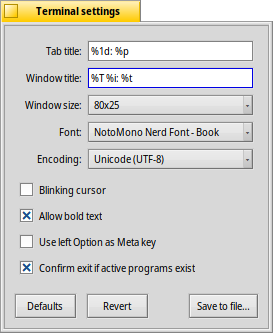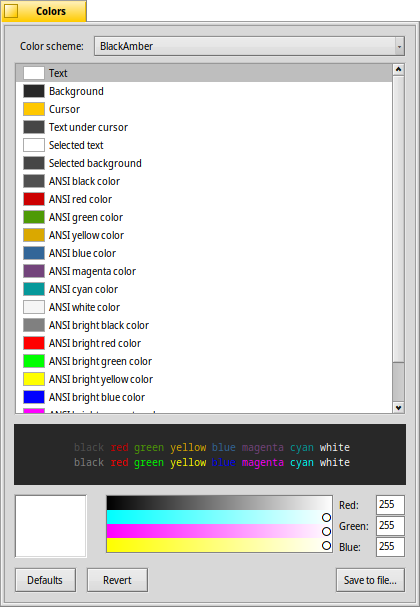| Index |
|
Windows and tabs Settings Colors Keyboard shortcuts Hints for working with the Terminal Bash customization |
 Terminal
Terminal
| Deskbar: | ||
| Localização: | /boot/system/apps/Terminal | |
| Definições: | ~/config/settings/Terminal ~/config/settings/profile - acrescenta/substitui os padrões em /boot/system/settings/etc/profile ~/config/settings/inputrc - acrescenta/substitui os padrões em /boot/system/settings/etc/inputrc |
The Terminal is Haiku's interface to the shell, by default that's bash, the Bourne Again Shell.
Por favor tome como referência o tópico sobre Scripting para encontrar alguns links para tutoriais online sobre como trabalhar no shell e também faça uma leitura no tópico Aplicativos em linha de comando. Aqui, iremos nos concentar no aplicativo Terminal por si só.
 Janelas e abas
Janelas e abas
You can open as many Terminals as needed, either each in its own window by simply launching more Terminals or with ALT N from an already running Terminal. Or you use Terminal's tabbed view and open more tabs with ALT T. You can switch to a specific tab with ALT and its number, e.g. ALT 2 switches to the second tab, ALT 4 to the fourth etc.

Double-clicking into the emtpy part of the tab bar opens a new tab; onto a tab opens a dialog to rename its title. There are several %-designated variables that are explained with a tooltip when you hover the mouse over the text field.
By default, %1d: %p, a tab shows the current directory and, separated by a :, the name of the currently running process (or -- if it's just bash running, probably idling). The screenshot above shows the first tab with a FTP session in the Desktop folder and a second tab idling at home.
Via the Terminal window's title can be edited in a similar way.
Clicar com o botão direito do mouse em uma guia exibe um menu de contexto para , ou, como o duplo clique, .
Uma janela do Terminal pode ser redimensionada como qualquer outra janela ou usando as predefinições a partir do menu . ALT ENTER alterna para o modo de tela cheia.
All the settings you change directly through the menu, like , , or are only kept for the current session. If you want to make permanent changes, you have to either invoke or apply them in the panel.
 Configurações
Configurações
abre uma janela de diálogo para configurar as definições padrão de um Terminal.

Most of the offered settings speak for themselves. Not entirely obvious though, the font size is set in the submenu of the popup menu.
Hover your mouse over the "formulas" for naming tab and window titles to get tooltips for the available variables.
A few more options follow: you can have a and choose to .
if you work with certain UNIX software that relies on accessing an extended portion of the ASCII character set, like e.g. GNU Emacs and the GNU readline library.
Activate the checkbox to and you'll be warned when trying to close a Terminal window while an app is still being executed.
| let's you save different settings as separate profiles, which on double-click open an accordingly configured Terminal. | ||
| brings back the settings that were active when you opened the settings panel. | ||
| resets everything to default values. |
 Colors
Colors
opens a panel to configure the colors used by Terminal.

From the top menu, you can choose a pre-defined like or or create a one by selecting the color you want to change (, , etc.) and then use the color picker below.
You can also configure "ANSI colors", which are the first 8 named colors in the color palette of terminal applications. You choose a color, for example "ANSI red color", and then adjust it with the color picker below. The effect is visible live in the open Terminal and in the preview below. The exact colors used in various places are documented at Wikipedia.
| let's you save your custom color scheme under a name that will appear in the menu at the top, if you put it in the default location ~/config/settings/Terminal/Themes (or its system equivalent /boot/system/settings/Terminal/Themes). | ||
| brings back the colors that were active when you opened the colors panel. | ||
| resets everything to default values. |
 Atalhos de teclado
Atalhos de teclado
Você encontrará uma lista de atalhos úteis em Atalhos e combinações de teclas.
Outra funcionalidade bacana que é mais uma combinação mouse & teclado: Ao apertar ALT um caminho ou URL abaixo do ponteiro do mouse fica destacado. Um clique com o botão esquerdo abre o arquivo/pasta ou sítio da web. Um clique com o botão direito abre um menu de contexto para ou . Imagine que esteja em /MyData/source/haiku/ e tenha o caminho generated/objects/haiku/x86_gcc2/release/apps/stylededit/StyledEdit sob o ponteiro do mouse, o último item do menu resultará no caminho absoluto, combinado <suspiro profundo>:
/MyData/source/haiku/generated/objects/haiku/x86_gcc2/release/apps/stylededit/StyledEdit.
Se apertar ALT SHIFT, apenas o caminho do começo até onde o ponteiro do seu mouse está será destacado.
A propósito, um clique com o botão direito do mouse dentro da janela do Terminal inserirá o conteúdo da área de transferência. Em combinação com partes copiadas de caminhos destacados, isto pode ser utilizado para nevagação rápida em hierarquias compridas de pastas.
 Dicas para trabalhar com o Terminal
Dicas para trabalhar com o Terminal
Arrastar um arquivo ou pasta de uma janela do Rastreador para o Terminal inserirá seu caminho no local do cursor. Arrastar com o botão direito do mouse oferece ações adicionais em um menu de contexto:
Insere o local do arquivo, o mesmo que o arrastar e soltar com o botão esquerdo do mouse. Alterna para a pasta do arquivo arrastado. Cria um vínculo para o arquivo arrastado no diretório atualmente acessado pelo Terminal. Move o arquivo arrastado para dentro do diretório atualmente acessado pelo Terminal. Copia o arquivo arrastado dentro do diretório atualmente acessado pelo Terminal. You can open any file with its preferred application with the command open [filename]. This also works with the representation of the current (".") and parent ("..") folder which then open in a Tracker window. So, to open the current working directory, you type:
open .
If a command generates lots of output, things scroll by rapidly. Use a few of those commands and it gets difficult to scroll back and find the start of the last output. With or ALT L you can clear the scroll back buffer before issuing your command. Presto, a pristine empty scroll back buffer, you can just scroll back right to the top to catch the beginning of your output.
 Personalização do Bash
Personalização do Bash
Vindo do Unix, existem incontáveis possibilidades para personalizar o próprio bash. Existem dois arquivos que são especialmente importantes para o usuário: profile e inputrc.
Ambos podem ser criados na pasta /boot/home/config/settings/ e adicionar ou sobrepor os padrões do sistema que são definidos em /boot/system/settings/etc/.
profile
O profile é carregado toda vez que se abre um novo Terminal. Ele define todos os tipos de apelidos e variáveis que afetarão o comportamento e a aparência do bash. Você encontrará muitos recursos online que detalharão todas as possibilidades.
O Haiku/BeOS Tip Server tem algumas dicas para que possa começar, por exemplo:
- Personalize o prompt do seu Terminal
- Mais personalizações do prompt
- Enhancing bash
- Custom keyboard shortcuts
There are more, have a look.
inputrc
O inputrc mexe com combinação de teclas. Uma vez que o Haiku proporciona padrões úteis, provavelmente não precisa se atrapalhar com estas definições mais complicadas. Se possui necessidades especiais aqui, consulte um dos muitos recursos online, por exemplo The GNU Readline Library.